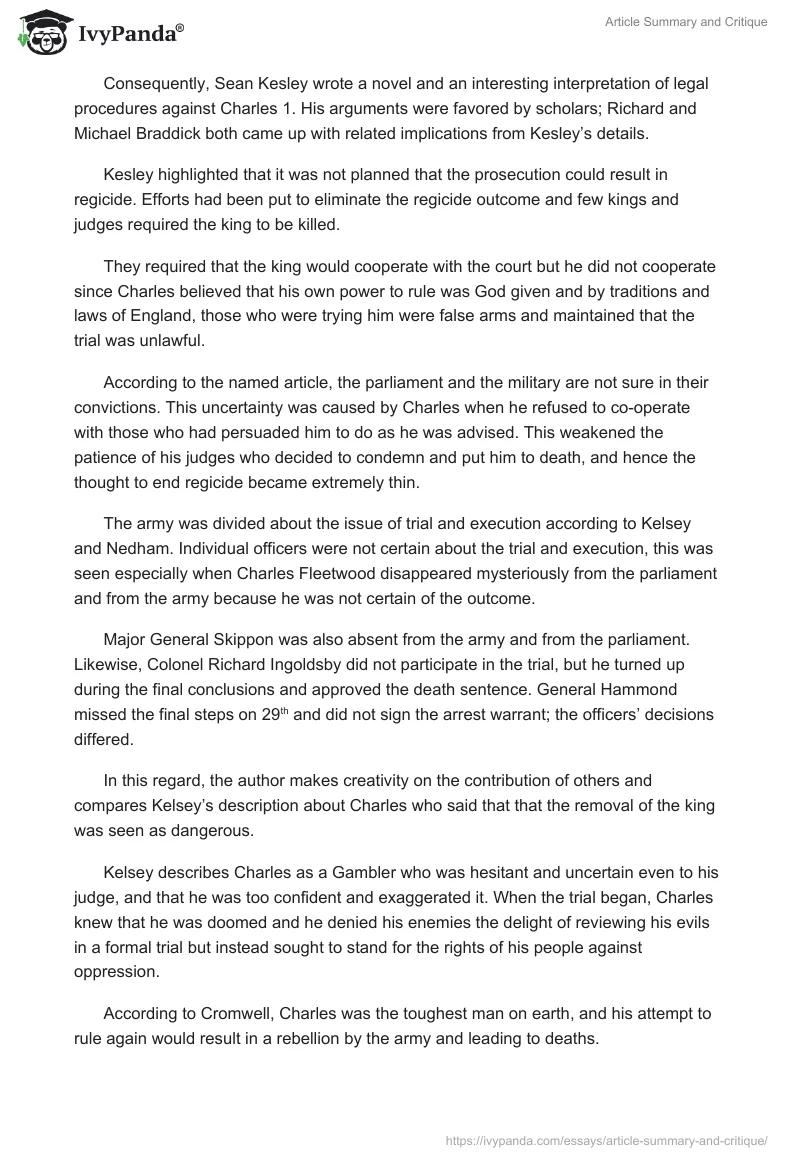Charles I was the first king of the England’s royal leader to face trial for betrayal which led to his execution. It was one of the most contentious and prominent incident in England’s history.
There was no law in England’s history that dealt with the prosecution of a king and so, the rule of organizing the court for Charles’s trial was compiled by a Dutch lawyer called Issac Dorislaus, and his rule was supported by an ancient Roman law which was written down that the government could legally bring down a tyrant.
This paper analyses the research with the same title conducted by Holmes (2010).
Charles’s 1 fate was to be decided by 135 judges, but only 68 appeared before the trial. Those who did not attend were not happy about the trial and did not want to be linked with the case.
MP’s who were on parliament did not want to see the king put on trial, but in December 1648, the MP’s were prevented from going to the parliament by a colonel who was joined by some soldiers. Those who supported the trial were the only ones who attended the parliament proceedings.
The execution of Charles 1 was viewed by his friend and enemies as unavoidable. Some said that they could not be secure while he remained alive because they referred to him as a cowardly cruel man who had initiated and won the war. They prayed and reflected both the first and second civil wars and came to a conclusion that the lord’s reason was to deal with the king as a killer.
S.R Gardener considered the wait between the army’s coup and the elimination of the parliament on 6th December, and later the execution after seven weeks was a deliberate delay.
He thought the votes regarding the sentence were noted as just a beginning and not binding, perhaps because they were passed by only 46 representatives. He also indicated that those among the judges who supported the planning of a capital sentence believed that he could only be removed from power by putting him to death.
Consequently, Sean Kesley wrote a novel and an interesting interpretation of legal procedures against Charles 1. His arguments were favored by scholars; Richard and Michael Braddick both came up with related implications from Kesley’s details.
Kesley highlighted that it was not planned that the prosecution could result in regicide. Efforts had been put to eliminate the regicide outcome and few kings and judges required the king to be killed.
They required that the king would cooperate with the court but he did not cooperate since Charles believed that his own power to rule was God given and by traditions and laws of England, those who were trying him were false arms and maintained that the trial was unlawful.
According to the named article, the parliament and the military are not sure in their convictions. This uncertainty was caused by Charles when he refused to co-operate with those who had persuaded him to do as he was advised. This weakened the patience of his judges who decided to condemn and put him to death, and hence the thought to end regicide became extremely thin.
The army was divided about the issue of trial and execution according to Kelsey and Nedham. Individual officers were not certain about the trial and execution, this was seen especially when Charles Fleetwood disappeared mysteriously from the parliament and from the army because he was not certain of the outcome.
Major General Skippon was also absent from the army and from the parliament. Likewise, Colonel Richard Ingoldsby did not participate in the trial, but he turned up during the final conclusions and approved the death sentence. General Hammond missed the final steps on 29th and did not sign the arrest warrant; the officers’ decisions differed.
In this regard, the author makes creativity on the contribution of others and compares Kelsey’s description about Charles who said that that the removal of the king was seen as dangerous.
Kelsey describes Charles as a Gambler who was hesitant and uncertain even to his judge, and that he was too confident and exaggerated it. When the trial began, Charles knew that he was doomed and he denied his enemies the delight of reviewing his evils in a formal trial but instead sought to stand for the rights of his people against oppression.
According to Cromwell, Charles was the toughest man on earth, and his attempt to rule again would result in a rebellion by the army and leading to deaths.
Charle’s trial was biased because it was twisted, and he was also given many chances to plead before they executed him. By doing this they thought that the conciliation could be resurrected. In essence, the proceedings on 24 and 25 January, when views of the witnesses against the Kings trial were seen as an effort to setback the trial.
In conclusion, clearly Charles 1 was an arrogant person and he refused to defend himself when he was asked by the judges to do so. He did not recognize the authority of the court and he declined to take off his hat as a sign of respect to the judges. The author of the named article has presented the facts with enough evidence.
Although the evidence which is available is not easy to assess and is marked by wishful thinking and self interest, it can be concluded that Charles 1 was a dangerous and arrogant person who did not recognize his own faults. He only defended himself when his judgment was announced by the court but since his chance had gone, he was taken out and the judgment date was set.
Work Cited
Holmes, Clive. “The Trial and Execution of Charles I. The Historical Journal 53 (2010): 289-316. Doi:10.1017/S0018246X10000026.


